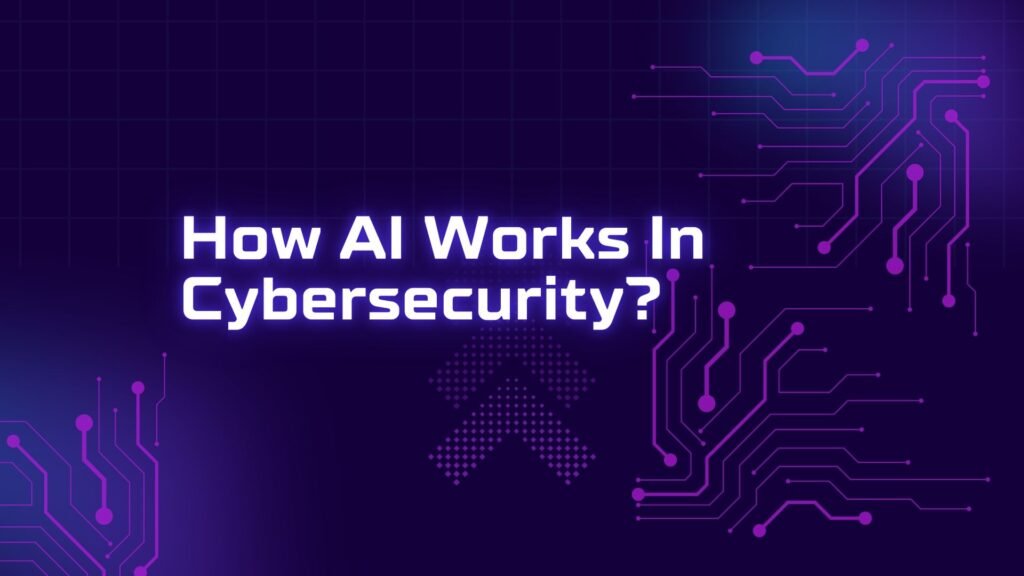AI and Security threats in AI and cybersecurity are evolving fast. Discover the new risks, challenges, and protection strategies in the digital age are incorporated into every field of our lives nowadays. Knowing these threats ensures you can keep your data safe and solve issues.
Cybersecurity and artificial intelligence keep improving. Organizations and companies use them in professional procedures to generate revenue and retain their employees focused on more attention-requiring matters.
Cybersecurity is also effective for managing cyber attacks and threats. Businesses using AI and cybersecurity together simplify the path to success.
However, with their evolution, users must consider new threats and risks for safe use.
Table of Contents
ToggleNew Solutions
The following are the considerations for managing the risks and issues using AI and cybersecurity technologies.
How AI Works In Cybersecurity?

AI transforms cybersecurity. It helps revolutionize how organizations detect, prevent, and manage cyber threats. Using AI in cybersecurity offers the following advantages.
Threat Detection And Prevention
AI-specific security systems use ML algorithms to analyze massive amounts of data and identify patterns connected with cyber threats. Traditional security measures depend on predefined rules, and they mostly fail because of constantly changing threats. AI improves threat detection by:
- Examining anomalies in network behavior.
- Identifying malware patterns and phishing attacks.
- Detecting zero-day vulnerabilities before they are exploited.
Automated Incident Response
AI decreases response times by automating incident detection and mitigation. AI Security automation tools can isolate compromised systems before damage spreads. They provide real-time threat examination and remediation suggestions, decreasing reliance on manual security monitoring.
Detection Of Fraudulent Activities
Organizations and companies use AI systems that help detect fraudulent activities in real-time. For this purpose, they examine the user’s behavior and transaction history. They can prevent financial loss this way.
Anticipate Threats And Risks
Security professionals use AI systems and tactics to examine global threats and risks by staying ahead of cybercriminals. Organizations use predictive analytics to anticipate risks and issues, which helps them improve their security measurements accordingly.
AI Cyber Threats Are Increasing
Even though AI and cybersecurity benefit security professionals and organizations, they introduce deadly cyber threats. Cybercriminals use AI to develop hacking methods to destroy traditional security measures.
Phishing Attacks With AI
It is a notorious cyber threat, and the availability of AI systems makes them easy targets for cybercriminals. They can use AI to
- Create phishing emails.
- Impersonate high-profile people to scam people.
- Copy their writing styles.
- Mimic their activities.
They can also automate large-scale phishing attacks with excellent success rates.
Deepfake Advancements And Identity Fraud
AI deepfake technology allows cybercriminals to make advanced and totally real audio and video content. It’s a significant cyber threat and risk. Cybercriminals use deepfakes to copy executives for financial frauds, manipulate political and social narratives, and create fake identification documents.
AI Malware
AI helps cyber criminals create self-learning malware that adapts security measures. It can destroy traditional antivirus detection systems. Cybercriminals can modify their code to avoid pattern-based solutions. They can increase their impact by spreading autonomously.
Automated Cyber Attacks
AI-powered automation allows hackers to execute large-scale attacks without human interruption. This includes:
- Botnets that launch DDoS attacks.
- AI-based brute force attacks to crack passwords faster.
- Automated reconnaissance tools to identify security weaknesses.
Data Poisoning Attacks
Data poisoning includes corrupting data used in training AI models. If attackers add malicious and corrupted data to AI training datasets:
- They can mislead AI-based security systems.
- Corrupt automated decision-making procedures.
- Create vulnerabilities in AI-driven cybersecurity solutions.
Cybersecurity Betterment Using AI
Preferring AI tactics to handle cybersecurity threats is a great way to do this in companies and professional settings. The following strategies prove effective for such purposes.
AI-Powered Security Frameworks
Organizations must add AI into their cybersecurity frameworks to enhance real-time threat decision, response, and prevention. AI security tools can conduct continuous network monitoring. They provide predictive analytics to eliminate threats. They are also beneficial for automating security patches and updates.
Human-AI Collaboration
Although AI offers several benefits, human intervention is highly beneficial. Organizations must adequately train cybersecurity professionals to use AI tools and develop AI security teams. That combine human judgment with machine intelligence. They should conduct regular cybersecurity training to prevent human errors.
Ethical AI Implementation
Companies must develop ethical AI systems to mitigate AI-relevant risks. Maintain transparency while implementing AI decisions, and ensure biased-free AI algorithms to prevent discrimination. They must conduct rigorous testing before deploying AI security tools and systems.
Improved Authentication Techniques
Traditional passwords are no longer sufficient. AI authentication solutions, such as behavioral biometrics, AI multi-factor authentication, and continuous authentication, must be used to detect unauthorized access.
AI-Driven Threat Intelligence Sharing
AI cyber threats are easy to eliminate when governments and organizations work together. AI can facilitate real-time sharing of threat intelligence across different industries. It helps global security networks detect and neutralize threats before they become dangerous. It can also enhance cyber resilience through cross-sector cooperation.
The Future Of AI And Cybersecurity
AI and cybersecurity will keep evolving, and security professionals and cybercriminals will use them. However, different trends affect their work.
- Governments and organizations will make other rules for using AI in cybersecurity.
- Quantum computing trends are making security obsolete, so new passwords and security systems are required.
- Cybersecurity systems with AI programs for self-repair and adaptation will gain more popularity.
- AI will help organizations identify internal threats by monitoring employee behavior and access patterns.
Conclusion
To conclude, AI and Cybersecurity: A New Era of Threats and Protections. Cybersecurity and AI are two necessary fields that are gaining continuous popularity. Learning their working and ensuring improved technologies ensure you can detect and mitigate threats appropriately.




